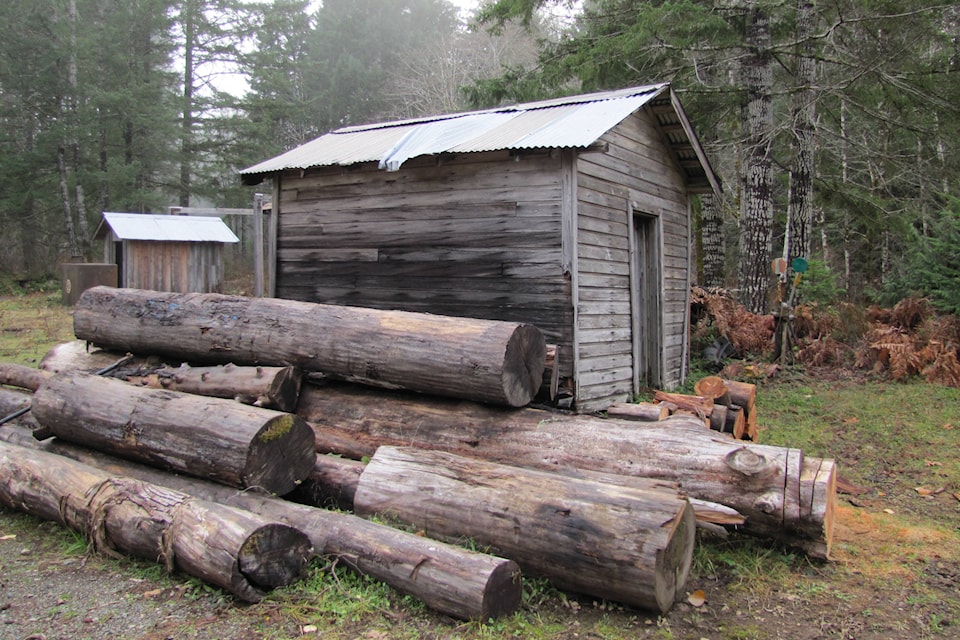An historic building at the McLean Mill National Historic Park has been demolished, and members of the Alberni Valley Heritage Commission are worried this will threaten the mill’s historic status—and funding.
The Heritage Commission learned during a meeting on Friday, June 6 that the historic First Aid Shack at McLean Mill had come down earlier last month, and the remnants discarded in a dumpster.
The shack was located within a Parks Canada declared historic zone, so commission members are concerned about the consequences this might have on the historical status of the mill—which could lead to the loss of federal funding.
“I feel it’s a huge loss to our historical artifact collection,” added commission member Pam Craig.
The situation is complicated, said Alberni Valley Museum manager Jamie Morton.
“The issue is Parks Canada said it was to be maintained in its preserved condition,” he said. The loss of this one building, he added, could have an impact on the “commemorative integrity” of the site.
In the 1990s, Parks Canada introduced the concept of commemorative integrity to ensure that third-party operators of historic sites wouldn’t impair the ability of the site to tell its story. McLean Mill was designated an historic site, said Morton, because of the mix of buildings that served different functions.
“They told all the stories of the forest industry in one compact site,” he explained.
The threat is whether or not Parks Canada catches wind of the incident and decides that it breaks the terms of the original agreement.
“I honestly don’t know how concerned they’ll be about this happening 20 years into the agreement,” said Morton. “But there is that kind of threat. It’s something that shouldn’t happen.”
According to McLean Mill Society president Bill Collette, the shack had fallen down and had been disassembled for safety reasons.
“The building was in some trouble,” he said. “It was a small building and it was visibly not in good shape. Some of the building remains were removed from the property,” he admitted. “We didn’t handle that as well as we should have.”
The First Aid Shack was a small building near the rail line, located on log skids so that it could move around as required.
“People are walking through there all the time,” said Collette. “We have to be cognizant of safety. Ideally, [the remains] would have been secured,” he added. “We accept our level of responsibility for not handling it properly.”
The McLean Mill Society does its best to adhere to preservation guidelines, said Collette.
“But we’re operating a business surrounding the historic site, so we’ve got some juggling to do,” he added. “We’re trying to ease the burden on taxpayers, without destroying the heritage of the site.”
Collette said he does not believe that other buildings on the property are in a similar state of near-collapse.
“[The shack] certainly appeared to be unstable,” said Collette. “Other buildings do not appear to be in that sort of condition.”
The problem is that any work done on the site has to be approached carefully to ensure that commemorative integrity is maintained, which limits repairs and investments. “Everything we do requires quite a bit of investigation,” said Collette.
This is not the first time a building has collapsed at the site. Years ago, the R.B. McLean House fell down, but the process was well-documented, pieces were collected and the building was reconstructed. In the case of the First Aid Shack, pieces were removed.
“A building falling down isn’t the big problem,” said Morton. “You try to protect and preserve what is there. This one ended up in the dumpster.”
The city, said Morton, is now in a “reactionary” situation, but a monitoring process of some kind could have prevented the loss.
“If it had been made evident, more appropriate action could have been taken,” he said. “That’s what the commemorative integrity piece is for. The people operating the site are not professionally trained to manage historic sites. [They] have to be cognizant, and they have to be in touch.”
Both Collette and Morton confirmed that there is a conservation engineer in the process of writing a report on the status of the site. Something like this, said Morton, could provide a baseline document for preservation.
“All we can do is try and do better next time,” said Morton.
